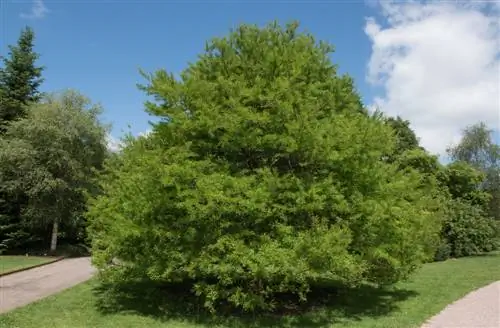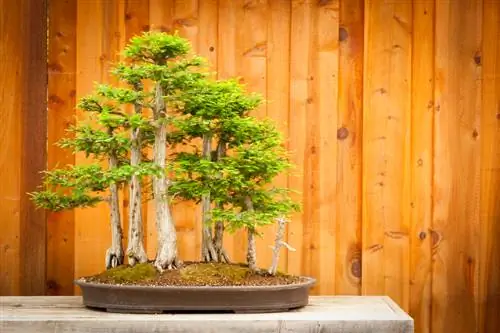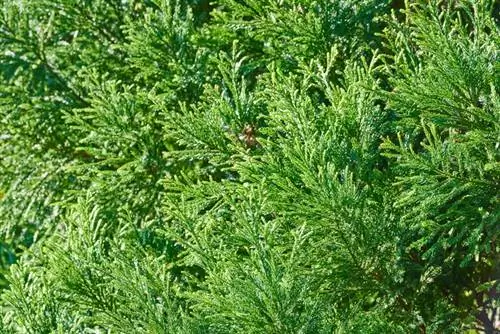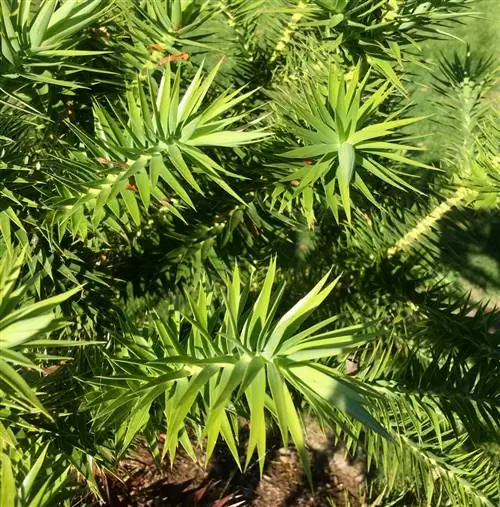- Author admin [email protected].
- Public 2023-12-16 16:46.
- Last modified 2025-06-01 06:02.
Hobby gardeners know the problem: There is a gap in the planting plan for the wet location. Near the banks of the garden pond or stream, swamp-friendly plants remain at knee height. No sign of wind or privacy protection. The green problem solver is the majestic bald cypress with special breathing roots. The profile, planting and care instructions reveal why this is so. Here you will find out how you can use bald cypresses to decorate flooded, swampy locations in a decorative, windproof and opaque way.

What are the characteristics and conditions for growing a bald cypress?
The bald cypress (Taxodium distichum) is a deciduous coniferous tree with a growth height of 30-40 meters, requires a sunny location and thrives in moist-wet to swampy or moderately dry soils with acidic to neutral pH. It is easy to care for and has conspicuous respiratory roots as well as a rusty brown autumn color.
Profile
- Scientific name: Taxodium distichum
- Family: Cypress family (Cupressaceae)
- Synonym: swamp yew
- Type: deciduous conifer
- Growth: conical crown
- Growth height: 30 to 40 m
- Leaf: alternate needles
- Flower: cones
- Flowering period: February to April
- Fruit: spherical cones
- Root: Heartroot
- Winter hardiness: hardy
Growth
Monumental growth and an elegant, conical crown characterize the bald cypress. Under the furrowed, reddish-brown bark, the extravagant conifer contains high-quality, long-lasting wood with decorative grain. From an age of 100 years, the wood is considered particularly rot-resistant and is used, for example, in boat building or in outdoor structures that are exposed to wind and weather. With an annual growth of 25 to 35 centimeters, the bald cypress is one of the relatively fast-growing conifers and quickly supplies supplies for the wood industry.
Conifers are very popular in forestry thanks to their unique growth characteristics. For this reason, populations in Central Europe are declining dramatically. Bald cypresses are now rare in the wild. That was not always so. Fossil finds from the Tertiary period in German brown coal mining prove that bald cypresses were widespread in the forests of our continent in ancient times.
Leaf
Bald cypresses have a dense foliage of soft, dark green needles. Seen from a distance, the foliage is reminiscent of a yew tree, which is what the second name Swamp Yew refers to. In the swamps and floodplains of South America, the cypress family thrives as evergreen trees. In the cool regions of Central Europe, the conifers shed their needle-shaped leaves after a spectacular copper-red to rusty-brown autumn color.
Flowering time
During the flowering period, male and female flowers can be admired on bald cypresses. Cypress plants are characterized by growth as monoecious, separate-sex seed plants (monoecy). Male flowers begin in winter, followed by female flowers from the beginning of March into April. The following table lists the differences:
| Bald Cypress Blossom | Male flower | Female Flower |
|---|---|---|
| Size | 5 to 10 cm | 2 to 3 cm |
| Shape | elongated | spherical |
| Arrangement | double grape | individually or grouped |
| Position | Branch tips | Leaf axils |
Fruit
The spherical cones have a diameter of 1.2 to 3 centimeters. After pollination by the wind, bald cypress cones are initially green and later reddish brown. From October onwards, the ripe fruits spread apart to release their seeds. Each cone contains 20 to 30 narrow winged seeds.
Root
Swamps as a habitat do not deter the extraordinary cypress because it can rely on an ingenious root system. A strong, deep taproot guarantees stability in wind-exposed locations. To ensure that the heartroots do not suffocate when planted in shallow water, furious breathing knees up to 50 centimeters high are formed. It is a root metamorphosis for the continuous oxygen supply to the roots below the water level.
Excursus
Thickest tree in the world
A superlative bald cypress can be admired in the Mexican village of Santa María del Tule. There, a Mexican bald cypress (Taxodium mucronatum) boasts a trunk circumference of a whopping 58 meters and a diameter of 12 meters. The stately cypress is reverently called “El Gigante” (the giant) and enjoys worldwide fame, as the following video shows:
Planting bald cypress - tips & tricks
In the tree nursery you can get ready-to-plant bald cypresses in containers or as bales. You can find out what you should pay particular attention to when planting in the following sections:
Location
Swamps are just one of many habitats for Taxodium distichum. The adaptable conifers are heat-tolerant, wind-resistant and exhaust-tolerant. The bald cypress cannot get used to a shady, very dry, lime-rich location. This allows planting in urban and rural regions, in parks and gardens with these general conditions:
- Sunny to full sun location
- Wet, swampy and flooded clay soil to moderately dry, sandy soil
- Ideally acidic to neutral pH value of 5 to 6
To enjoy the bizarre breathing roots, you can plant a bald cypress in the middle of a body of water or near the bank. Please note two important premises for these location variants: There must be no foil cover. Furthermore, the natural pond for the majestic original species should be several hundred square meters in size so that the annual needle masses do not silt up your water world.
Planting
The best time to plant is in spring. Young bald cypresses from the nursery are sensitive to frost. Planting between March and May gives the conifers enough time to become firmly rooted in the ground before the first frost. You can improve sandy-dry garden soil with leaf compost or ericaceous soil. Loosen the soil at the site thoroughly before digging the generously sized planting pit. Place a support post on the side of larger bald cypress trees. Please hammer this into the ground at an angle because the trunk usually has side branches down to ground level.
Bald Cypress - Care Tips
Bald cypresses are easy to care for. The following care tips provide a compact overview:
Pouring
In the first few years, ideally water a bald cypress with rainwater when it is dry. A regular supply of fresh water must be ensured at the flooded location, because in brackish water the roots are at risk of rot.
Fertilize
Flood zones and shallow water near the banks make it unnecessary to add fertilizer because pond water transports enough nutrients to the roots. If the swamp yew thrives in normal garden soil, add compost with horn shavings in March/April or mulch the tree disc with bark humus.
Propagate
The easiest way to propagate bald cypresses is by sowing. The following quick guide explains how to do it correctly:
- Collect ripe cones in October and November
- Keep dry and airy until spring
- Remove seeds from the cones in March
- Pre-germinate seeds for three weeks in soft, room temperature water
- Change water daily
- Sow germinating seeds in pots with coconut soil or seed substrate
In a bright location on a south-facing window, in the winter garden, on the glazed terrace or in the greenhouse, keep the soil constantly slightly moist. Repot your pupils into larger pots in proportion to their growth. From a plant height of 10 centimeters, fertilize with liquid conifer fertilizer (€44.00 on Amazon) in half the concentration.
Cutting
Bald cypresses naturally form their conical crown over time. Only prune the conifers when necessary. You can branch the conifers if the deeper side branches bother you. Thin out dead branches. The best time for regular pruning is in February on a frost-free day. However, the cypresses are still without their leaves during this time. If you would like to better assess the growth and needle pattern, cut a swamp yew at the end of June.
Popular varieties
The bald cypress is the powerful ancestor of numerous garden-friendly varieties that you can buy in any well-stocked tree nursery:
- Taxodium distichum 'Cascade Falls': shrub-like bald cypress, overhanging side branches, 100-400 cm tall.
- Bald cypress 'Secrest': broad, bushy, plate-shaped growth, 20-90 cm high, 40-300 cm wide, beautiful ground cover.
- Dwarf bald cypress 'Peve Minaret': slender, columnar cypress, 200 to 300 cm tall.
- Mini bald cypress 'Pendulum': 30-50 cm high, 20-30 cm wide, ideal for small gardens and pots.
- Mexican Bald Cypress: Rarity, Mexican national tree, 40 m tall.
FAQ
What is the difference between bald cypress and sequoia?
The bald cypress is closely related to the sequoia tree (Metasequoia glyptostroboides). The cypress plants can be distinguished primarily by the growth of their needles. The needle-shaped leaves of the bald cypress are arranged alternately. The sequoia tree has opposite foliage.
Can you plant a bald cypress in a pot?
Small varieties, such as the dwarf bald cypress 'Peve Minaret' or the mini bald cypress 'Penulum', are primarily suitable for permanent planting in a pot. Real bald cypresses are a beautiful eye-catcher in a large pot for up to five years and should then be planted out in the garden. We recommend slightly acidic rhododendron soil as a substrate. A regular supply of water and nutrients and light winter protection are important for care.
What properties does bald cypress wood have?
The wood of bald cypresses is highly valued because it is easy to work with. It is rot-, nail- and screw-proof and accepts glue, paints and varnishes very well. The sapwood is creamy white, the heartwood is yellowish-brown. The abrupt color transitions are striking, creating the sought-after grain. Furthermore, the specific dry weight of Taxodium wood is 515 kilograms per cubic meter. After drying, there is a volume shrinkage of 10.5 percent.
How do the roots develop? Can you plant bald cypress trees near the house?
Bald cypresses are heart-rooted plants with strong taproots. The conspicuous lateral breathing knees, up to 50 centimeters high, only form in wet, swampy or flooded locations. Measure the distance to the house in proportion to the expected growth height and width. A real bald cypress grows up to 40 meters high and 10 meters wide. This growth makes a minimum distance of 5 meters from buildings sensible.






